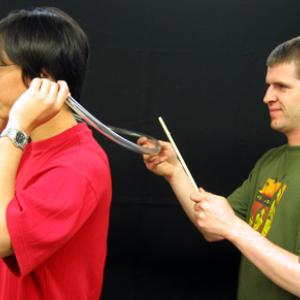College of Liberal Arts & Sciences
3C10.20 - Binaural Hearing
Hold the ends of the flexible tubing so that each end of the tube goes against an ear. Have someone tap on the tube in different positions. See how close to the middle of the tube you can come before you can no longer distinguish the time differential.
- Thomas D. Rossing, "Localizing Sound Underwater", TPT, Vol. 23, #7, Oct. 1985, p. 430.
- Morris G. Hults, "Binaural Hearing", TPT, Vol. 18, #7, Oct. 1980, p. 509.
- Stephen G. Benka, "Binaural Hearing for the Hearing-Impaired", Physics Today, Vol. 67, #3, Mar. 2014, p. 21.
- "W-035. Time Resolution of Ear", DICK and RAE Physics Demo Notebook.
- Pat Murphy, Ellen Macaulay, and the staff of the Exploratorium, "Where's That Sound Coming From?", Exploratopia, p. 20.
- Martin Gardner, "The Puzzling Snap", Science Tricks, p. 78.
- Raymond Bruman, "Stereo Hearing", Exploratorium Cookbook I, p. 69.1 - 69.2.
- "Stereo Sound", Science Snackbook, p. 94.1 - 94.2.
- "Hearing Test", PIRA Newsletter, Vol. 3, #17 Jan. 1990.
- Robert J. Brown, Science for You - 112 Illustrated Experiments, p. 39.
- "Perception of Direction with Sounds", Physics From the Junk Drawer, 3rd Edition, The Science House, North Carolina State University, p. 46.
- Janice VanCleave, "72. Sound and Direction", Janice VanCleave's 201 Awesome, Magical, Bizarre, & Incredible Experiments, p. 39.
- Martin Keen, "Two Ears are Better than One", Let's Experiment, 1968, p. 156 - 157.
- "Sense and Non-Sense with Your Five Senses", Science Experimenter Magazine, p. 60 - 62.
- Jane Bingham, "Surprising Senses", The Usborne Book of Science Experiments, p. 12 - 13.
Disclaimer: These demonstrations are provided only for illustrative use by persons affiliated with The University of Iowa and only under the direction of a trained instructor or physicist. The University of Iowa is not responsible for demonstrations performed by those using their own equipment or who choose to use this reference material for their own purpose. The demonstrations included here are within the public domain and can be found in materials contained in libraries, bookstores, and through electronic sources. Performing all or any portion of any of these demonstrations, with or without revisions not depicted here entails inherent risks. These risks include, without limitation, bodily injury (and possibly death), including risks to health that may be temporary or permanent and that may exacerbate a pre-existing medical condition; and property loss or damage. Anyone performing any part of these demonstrations, even with revisions, knowingly and voluntarily assumes all risks associated with them.
